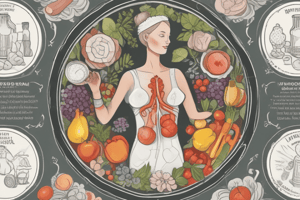Podcast
Questions and Answers
What is the unit of heat energy mentioned in the text?
What is the unit of heat energy mentioned in the text?
- Calorie (correct)
- Kelvin
- Watt
- Joule
Which of the following is NOT considered a basic nutrient according to the text?
Which of the following is NOT considered a basic nutrient according to the text?
- Fiber (correct)
- Fats
- Vitamins
- Proteins
How is Body Mass Index (BMI) calculated?
How is Body Mass Index (BMI) calculated?
- Weight in kg multiplied by height in meters
- Weight in kg divided by height in meters squared (correct)
- Weight in grams multiplied by height in centimeters
- Weight in pounds divided by height in inches
Which of the following factors is NOT mentioned as affecting nutrition in the text?
Which of the following factors is NOT mentioned as affecting nutrition in the text?
What type of diets may require complementary protein sources and supplements according to the text?
What type of diets may require complementary protein sources and supplements according to the text?
Which nutrient category is crucial for anabolism, catabolism, and nitrogen balance?
Which nutrient category is crucial for anabolism, catabolism, and nitrogen balance?
What is the role of micronutrients in the body?
What is the role of micronutrients in the body?
Which nutrient is primarily responsible for energy conversion and storage in the body?
Which nutrient is primarily responsible for energy conversion and storage in the body?
What is the main difference between complete proteins and incomplete proteins?
What is the main difference between complete proteins and incomplete proteins?
Which mineral category includes those required in daily amounts over 100 milligrams?
Which mineral category includes those required in daily amounts over 100 milligrams?
Flashcards are hidden until you start studying
Study Notes
- The text begins with a prayer before the lecture, emphasizing the importance of learning in different mediums and for the greater glory.
- The lesson topic is nutrition, with defined learning outcomes including identifying essential nutrients and factors influencing nutrition throughout the cycle.
- Macronutrients are energy-providing nutrients needed in large amounts, while micronutrients are required in small amounts to metabolize energy-providing nutrients.
- Carbohydrates are composed of simple sugars (monosaccharides) and complex starches and fibers, essential for energy metabolism.
- Proteins are essential for tissue growth and maintenance, categorized into essential (must be ingested) and non-essential amino acids (can be manufactured by the body).
- Proteins are classified as complete (contain essential amino acids) and incomplete (lack one or more essential amino acids), crucial for anabolism, catabolism, and nitrogen balance.
- Lipids include fatty acids and cholesterol, with fats solid at room temperature and oils liquid, playing a role in energy conversion and storage in the body.
- Vitamins are organic compounds categorized into water-soluble (e.g., Vitamin C) and fat-soluble (e.g., Vitamin A), crucial for disease prevention and overall health.
- Minerals include macro minerals (e.g., calcium) required in daily amounts over 100 milligrams and micro minerals (e.g., iron) required in smaller daily amounts, crucial for various bodily functions.
- The video summary discusses the importance of six basic nutrients: water, vitamins, proteins, fats, minerals, and carbohydrates, highlighting their functions in the body.- Energy balance involves energy intake and output, with calorie being the unit of heat energy.
- Basal metabolic rate is the rate at which the body metabolizes food at rest.
- Resting energy expenditure is the calories required to maintain basic body functions.
- Ideal body weight is recommended for optimal health, calculated with standardized tables or BMI.
- Body mass index (BMI) is calculated as weight in kg over height in meters squared.
- Factors affecting nutrition include development, sex, ethnicity, beliefs, lifestyle, economics, medications, health, alcohol, advertising, and psychological factors.
- Nutritional variations throughout the life cycle include neonates fed on demand, infants transitioning to solid foods, toddlers weaning off breast milk, and adolescents at risk for eating disorders.
- Dietary guidelines for Americans suggest shifting to plant-based foods, reducing added sugars and fats, and exercising regularly.
- Filipino nutritional guidelines emphasize a balanced diet with essential nutrients and safe food practices.
- Vegetarian diets can be incomplete in proteins, requiring complementary protein sources and supplements.
- Altered nutrition can manifest as malnutrition (lack or excess of food substances) or undernutrition (insufficient intake).
- Nutritional assessment involves anthropometric measurements, biochemical parameters, clinical evaluation, and dietary history to determine nutritional status for proper care planning.- Different nursing diagnoses for nutrition include imbalanced nutrition, obesity, overweight, readiness for enhanced nutrition, activity intolerance, constipation, chronic low self-esteem, risk for infection, and knowledge deficits.
- Nursing interventions for nutrition involve maintaining or restoring optimal nutritional status, promoting healthy nutritional practices, preventing complications from malnutrition, managing weight, planning for home care, providing assistance with eating and meal preparation, educating on nutrition therapy, assessing self-care abilities, financial resources, and making referrals as needed.
- Caregivers should have at least basic knowledge of feeding clients, understanding their preferences, and ensuring safety during meal times.
- The concept of nutrition emphasizes the importance of being mindful of what we eat, as it directly impacts our health and well-being.
- The speaker encourages listeners to take care of their bodies by choosing nutritious foods, highlighting that health is not just about losing weight but about improving overall quality of life.
Studying That Suits You
Use AI to generate personalized quizzes and flashcards to suit your learning preferences.




